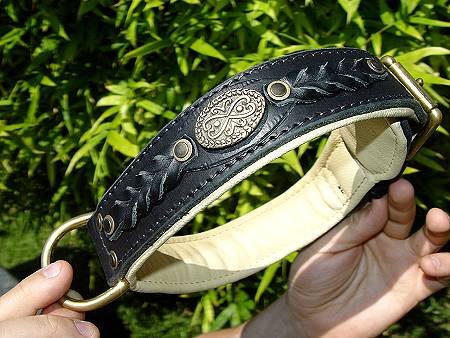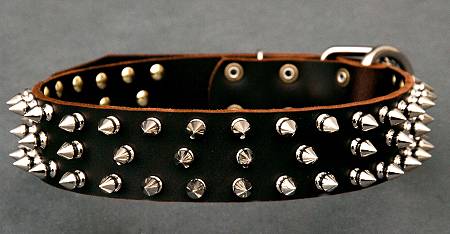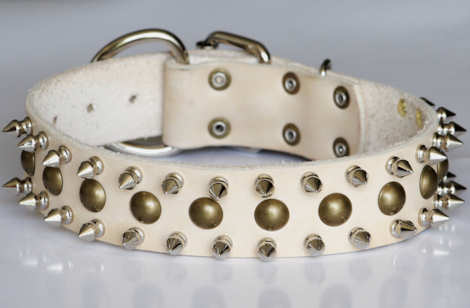Dog Collars - Dog Leashes
Buying a leash and collar for your pet should be simple, right? Like many things in life that seem simple, choosing a leash and collar is not. There are many different types of dog collars, designed around certain personality or medical needs. There are even special collars for cats! Leashes are usually designed to accommodate the lifestyle of the owner. We will look at different types of collars and leashes in this article.

We’ll first discuss the traditional dog collar. It is usually a piece of sturdy fabric that fastens like a belt. Multiple holes in the collar make it somewhat adjustable in size. This is helpful when you have a growing puppy, because you can just loosen the collar as its neck gets bigger. It is also convenient to have a traditional collar as a place to put the rabies and licensing tags.
There are also traditional collars that have been modified for behaviour reasons. For a long time, choke (also known as slip) collars and collars with spikes on the inside have been used to control unruly animals. These collars were preferred on dogs that continuously pull at their leash. The thought is that a choke or spiked collar would provide one quick instance of pain, and the dog would stop pulling. If this technique works, it is a very successful one. The problem is that many times the dog continues to pull. In these cases the collar may damage the neck or may cause the dog to have trouble breathing. If this is the case you may well be using the collar incorrectly and should stop using it until you get advice from your vet or a trainer.

You may also have heard of barking collars. These can be used on dogs that bark too much. The idea behind these collars is that the collar senses the vibration made when the dog barks. As soon as the dog barks, the collar makes something unpleasant happen. Hopefully the dog will quickly learn that barking is associated with something unpleasant. This unpleasant event is usually either a small shock or a spray of citronella. Interestingly, recent research appears to indicate that the citronella collars are more successful at deterring barking than the shock collars. Never just depend on a barking collar- always make sure to work with your dog to decrease barking in other ways too, such as minimizing stimuli and possibly using dog appeasing pheromones.

Cats can wear traditional collars, too. Many owners like to put their contact information on a cat’s collar, in case their outdoor cat gets lost or runs into trouble. However, due to their exploring nature, some cats can get their collar stuck on an object. If this happens, the cat may be stuck somewhere remote and be unable to leave, or even worse may “hang” itself by the collar if it was caught while jumping. This is why breakaway collars were designed. The buckle on a breakaway collar (which looks similar to a buckle on a fanny pack) will open simply if it is pulled hard enough. Therefore, if your cat gets stuck, the weight of the animal pulling on the collar will open the buckle. This can be a lifesaving event.
An alternative to the traditional dog collar is a harness. Harnesses are also popular with cat owners. There are many different types of harnesses, but in general the idea is to transfer the strain of pulling from the neck to the chest. Harnesses are designed to go under the front legs, across the chest, and the leash attaches along the back, just behind the shoulder blades. Some owners feel that they have better control over their pet with a harness. The two most common uses for a harness are to decrease neck pain and to ease breathing. Harnesses are popular options for animals that have had neck surgery or a slipped disc. They are also very useful for older animals that can have pain from arthritis in their neck joints. It is also recommended to use a harness on any breed of dog that already has trouble breathing (for example: pugs, bulldogs). Traditional collars can exacerbate their breathing difficulties.
The last type of collar we will mention is the ‘Haltie’. A Haltie is designed to allow the owner to gain control of the head. The strap goes behind the ears and over the top of the nose, and the leash attaches underneath the muzzle. If you can picture a horse halter, it is somewhat similar. When the dog pulls on the leash, it causes their head to be pulled to the side. When you have control of the dog’s head, you have more control over their pulling. Halties are very popular for behavioural control.
Once you chose a collar for your dog, you also need to choose a leash. There are two basic types of leashes- the set-length fabric leash and the retractable leash. You can choose a leash designed around your lifestyle and your pet’s exercise routine. Don’t forget to personalize your pet’s collar and leash. Your pet’s collar and leash can support your favourite sports team, celebrate the holidays, or make a statement of style.
Choosing a leash and collar can be fun but confusing. Make sure you choose a collar that works best for your pet. Comfort and control are the most important things to take into consideration when making this decision. Some breeds (such as greyhounds) even have breed-specific collar needs. Make sure you talk to your veterinarian about what collar and leash is right for your pet.
0 comments:
Post a Comment